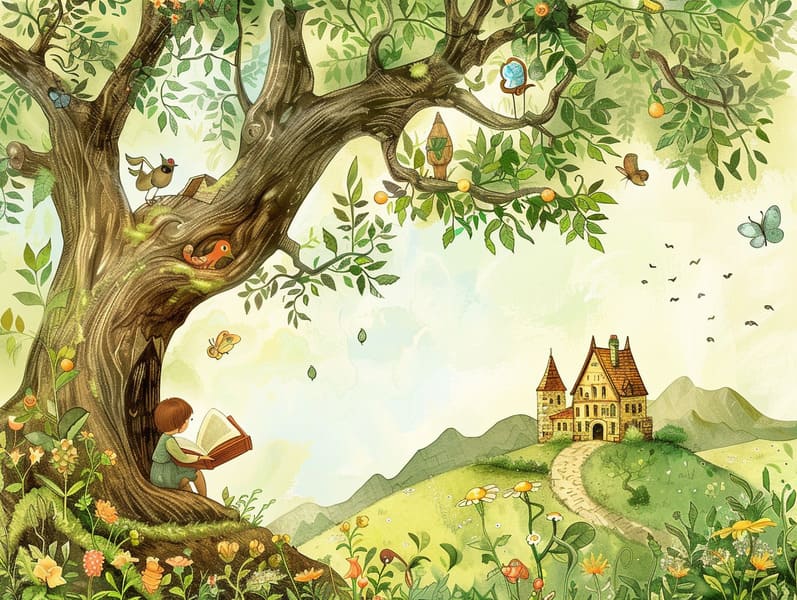
Traditional fairy tales have timeless appeal. These stories have been whispered from one generation to the next well before they were ever published. They developed from a variety of societies, including American traditions. They were initially shared among older generations, often carrying themes and messages aligned with the societal norms and beliefs of the time.
The Grimm brothers, the two Grimm brothers, were among the first to gather many of these beloved tales. Their volume, "Grimm's Fables," included narratives like "Cinderella," "The Story of Hansel and Gretel," and "Snow White," which have since become cornerstones in the world of children's fairy tales. Similarly, Hans Andersen's fanciful tales, such as "The Mermaid's Tale," and "The Ugly Duckling," have captivated hearts worldwide, solidifying their place in the pantheon of treasured fairy tales.
Even though they are old, fairy tales remain as meaningful as ever, especially as children's night stories. These whimsical stories are now available in diverse formats, including gorgeously illustrated books, captivating animations, and free fairy tales online.
Their lasting appeal can be attributed to several delightful features:
Life Lessons: Traditional fairy tales often convey important moral lessons. Narratives like "The Wolf and the Liar" teach the value of sincerity, while "The Tale of the Tortoise and the Hare" point out the merits of resolve and humility. These stories offer young readers clear distinctions between good and bad, molding their moral compass in a mild yet profound way.
Compassion and Knowledge: Classic fairy tales frequently involve individuals facing trials and tribulations, provoking young listeners to identify with their struggles and applaud their triumphs. For instance, "The Story of Beauty and the Beast" emphasizes the importance of seeing inner beauty to recognize the real character of a individual, promoting tenderness and knowledge.
Cultural Perception: Many old fairy tales are infused with the cultural contexts from which they bloomed. Engaging with these stories can provide enlightening views into different social structures, strengthening a sense of global insight and understanding.
Inventiveness and Imagination: The mythical elements in ancient fairy tales—enchanted lands—enliven children’s inventiveness. These narratives guide readers to magical realms, inspiring fantasy-filled thoughts and a sense of excitement that persists a lifetime.
Ancient fairy tales are not only delightful but also pedagogical. They work as entrancing tools in developing various cognitive and emotional skills in young ones. When fairy tales are told out loud, they boost language proficiency by introducing new terms and complex sentence structures. This practice also strengthens auditory perception and attention, as young readers focus on every detail, keen to see what happens next.
Furthermore, contemplating the themes and characters of fairy tales can sharpen critical thinking and thought processes. The young are taught to find patterns, anticipate outcomes, and make sense of cause and effect. These analyses also facilitate young ones reveal their thoughts and feelings, fostering their emotional intelligence.
In today’s technological age, the abundance of internet fairy tales has made these tales more reachable than ever. Digital sites and web apps extend comprehensive collections of bedtime fairy tales that can be seen or heard anytime, anywhere. Fairy tales told out loud are particularly widespread, featuring an interactive method for young readers to experience these alluring stories. Read-aloud stories and read-aloud videos bring characters and settings to life, often supplemented by bewitching background sounds and soundtracks that boost the story adventure.
The enduring charm of ancient fairy tales lies in their ability to shift to current eras while sustaining their basic principles. Contemporary reinterpretations of these tales often show more diverse protagonists and modern settings, making them meaningful to today’s audience. However, the basic principles of valor, understanding, and truth remain unchanged, continuing to touch readers of all ages.
Timeless fairy tales also offer a sense of security and comprehensibility. They extend a structured narrative with a clear beginning, middle, and end, often closing with the settlement of conflicts and the triumph of morality over wickedness. This constancy can be reassuring for young readers, showcasing a sense of solidity in an inconstant world.
Classic fairy tales continue to bewitch and guide new generations, maintaining their splendor and pertinence in modern society. As bedtime stories for kids, they bestow a perfect blend of charm and enlightenment, encouraging moral values, empathy, and creativity. The existence of web-based fairy tales and the favor of fairy tales narrated certify that these old tales remain find it here obtainable to new generations.
By perpetuating and telling these stories, we continue to treasure the rich tapestry of fables and cultural heritage. Whether you are delving into a richly illustrated book, perusing a virtual library, or playing an narrated book, the captivation of famous fairy tales is always within reach. These tales illustrate of the steadfast nature of fairy tales and its ability to hold us together across centuries and lands.
Regardless if you are delving into a vividly illustrated book, browsing a internet collection, or listening through an narrated book, the spell of old fairy tales is always within reach.
These stories remind us of the immortal effect of stories and its ability to join us across generations and cultures, making a tie that fascinates and enlightens alike.